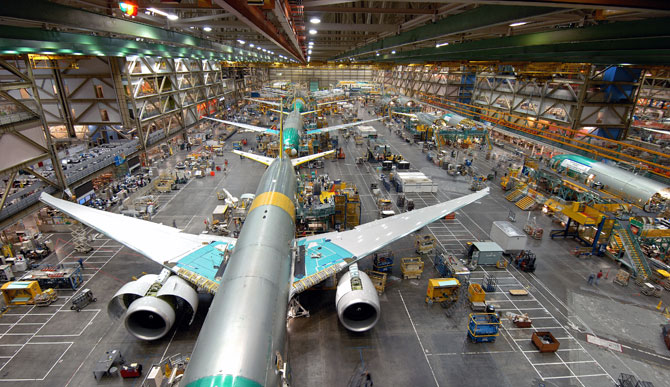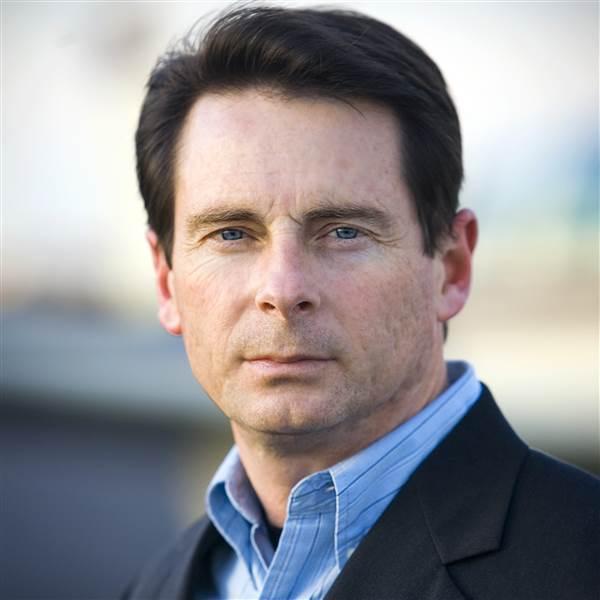
The 777 production line shows only a small part of the mammoth Boeing factory in Everett, Washington, that churns out widebody airliners for the world.
Boasting enough impressive stats to rival an NFL franchise, the Boeing factory tour in Everett, Washington, alone is reason enough for pilots to head northwest for a complete aviation geek-out, but there’s plenty more to do in the Seattle area to satisfy your airplane itch. However, without a doubt, the factory is—quite literally—the biggest thing around. In fact, by volume (472 million cubic feet) it is the largest building in the world. To play off that NFL reference a bit more, there’s enough floor space in the factory to host 75 simultaneous football games. Some of the doors are larger than a football field. You can bet these hangar doors don’t creak open by hand.
Boeing Factory
- Largest building in the world by volume according to the Guinness Book of World Records
- 472 million cubic feet
- 98.3 acres (4.3 million square feet)
- California’s Disneyland and 12 acres of parking would fit inside
- 1 million light bulbs
- 21,000 parking spaces
- 19 cafeterias
- 39 miles of ceiling tracks
- 2.33 miles of pedestrian tunnels
- 1,300 bicycles for employees
- Has its own fire department and security force
- The mural on the six factory doors is the largest digital graphic in the world
Some 1 million light bulbs—and a host of skylights—brighten the mammoth interior, where Boeing builds its widebody airplanes—the 747, 777, 767, and the new 787 Dreamliner. From catwalks and platforms around the plant, visitors gaze down and up at the enormous airplanes as construction progresses. Some of the production lines move at the rate of 1.5 inches per minute, but for some shifts the rate cranks up to five feet per minute. Currently, Boeing shoves about 1.5 widebodies out the door a month, although the facility is capable of about seven airplanes a month. As you can imagine, with the 787 now certified, every effort is under way to ramp up production of that model to eliminate agonizingly long backlogs.
Meanwhile, about 35 miles south of Renton, nearly 40 Boeing 737s flow out of another factory each month, along with a trickle of 757s, but there are no tours available at that facility.
Expect to spend the better part of a day experiencing the Everett factory and the related Future of Flight Aviation Center. A $16 to $20 ticket (depending on time of year) gets you the tour and access to the center, which hosts an abundance of exhibits and hands-on experiences showcasing the future of aviation. The center educates visitors about the materials and manufacturing techniques to build airliners and their engines, allows visitors to design their own airplane, and to clamber around in various airliner flight decks. Tickets can—and should—be purchased in advance online (see “If You Go,” page 68).
Numerous FBOs serve Everett’s Snohomish County (Paine Field), and they offer transportation to the center. You’ll know you’ve found the right airport when you get to the one littered with airliners in various states of completion—and no obvious airliner terminal.
The factory tour guides enjoy mesmerizing visitors with facts that help provide a sense of the outrageous size of the facility—California’s Disneyland could fit inside, with 12 acres left for parking. There are no environmental systems inside. People, equipment, and lights warm the place in the winter (some 32,000 Boeing employees work at the Everett complex; 65,000 in the Seattle area; and 170,000 worldwide). In the summer, opening those football-field-sized doors cools the place. So many employees work at the factory that their arrivals are staggered practically down to the minute of who is supposed to arrive when, in order to get one of the 21,000 parking spots and ease traffic flows.
While you’ll only walk about a third of a mile on the 90-minute tour, a trip around the perimeter is equivalent to a five-kilometer run.
On the tour, you’ll see just how different the models are one from another. For example, it takes three to four months to build an all-metal 747, but the company’s goal is five to seven days to complete a mostly composite 787—not including the three to five days to paint it. In one of three paint hangars, workers spray some 120 gallons of paint, weighing about 1,200 pounds, on each 747.
Finally, one last fact: There are 16 coffee shops inside the factory. This is, after all, Seattle.
Beyond the factory
After your Boeing tour and experience at the Future of Flight Aviation Center, fly south down Interstate 5 (IFR—I Follow Roads) about 35 miles to Boeing Field/King County International Airport (BFI), which is home to the Boeing customer delivery center and a host of flight test operations. Unfortunately, none is available for public tours, but as you taxi by you’ll see airliners emblazoned with airline names and liveries from around the world. Any of the several FBOs on the field can provide transportation to your next experience—the Museum of Flight, which is located on the airport.
 The Museum of Flight, located at Boeing Field/King County International Airport, is an aviation destination all its own, with dozens of aircraft and spacecraft on display—from light GA to airliners, and military aircraft. The museum also boasts a theater and many hands-on exhibits.
The Museum of Flight, located at Boeing Field/King County International Airport, is an aviation destination all its own, with dozens of aircraft and spacecraft on display—from light GA to airliners, and military aircraft. The museum also boasts a theater and many hands-on exhibits.
While there are many great aviation museums scattered around the country, as you might imagine, the one a stone’s throw away from the world’s largest airliner manufacturer has access to some particularly amazing aircraft, including a Boeing 707 that once served as Air Force One; a Concorde; and some stunning fighters and other military airplanes, past and present. And few visitors seem to recognize the contributions to space made by Boeing, something you’ll appreciate by the time you leave the space gallery.
Expect to spend a half-day poking around the massive complex that includes indoor and outdoor exhibits, theaters, and libraries. Tickets cost $17 for adults; see the website for pricing options.
While it’s amazing that you can actually walk around inside a Concorde and the Air Force One that carried presidents and former presidents Eisenhower, Kennedy, Johnson, and Nixon—and continued in VIP service until 1996—it’s a shame to see these unique artifacts sitting outside at the Airpark, where the elements take their toll every day. The old 707 with its 1960s-era executive interior seems quaint, with a typewriter resting at a secretary’s desk.
If you’re into restorations, you can trek back to Paine Field in Everett to the museum’s Restoration Center, where many projects are under way. See the website for tour details.
The Boeing-related experiences alone are good reason for pilots to make a visit to the Seattle area; however, there are many other aviation experiences waiting to be explored in that corner of the world.
For example, storied Kenmore Aviation is just across town at Kenmore
Air Harbor, a bustling seaplane base (see “Where Flying is ‘Still Fun,’” November 2011 AOPA Pilot), and the nearby San Juan Islands are a pilot’s paradise (see “Postcards: Friday Harbor, Any Day of the Week,” April 2010 AOPA Pilot).
Email the author at [email protected].
Boeing learns from GA composite success
A host of technology promises better ride for passengers and crew alike
The technological leaps made by Boeing with the 787 Dreamliner have been almost as noteworthy as the model’s trials, tribulations, and delays in coming to market. Taking a tip from general aviation manufacturers, Boeing has incorporated unprecedented levels of composite material into the new airliner—and seemingly taken full advantage of the weight savings and aerodynamic efficiencies possible with composites. Combined with new-generation engines, avionics, and other systems, the 787’s composite structures promise remarkable fuel savings and performance improvements over conventional airliners.
As the Dreamliner neared its entry into service late last year, we were given several opportunities to learn more about this impressive airplane, including access to Boeing engineers and pilots at EAA AirVenture during the summer of 2011 and an exclusive look at a flight test airplane and an airplane ready for delivery during a visit to the Boeing factory in Everett, Washington, later that fall. 
To give you a sense of just how much the 787 differs from conventional metal Boeings, consider that the company believes it can assemble one of the widebodies in five to seven days once production matures a bit. Compare that to the usual three- to four-month production process for a 747, which has been in production in one form or another since 1968.
A Boeing 777 has 50,000 fasteners in the wing alone. Altogether, Boeing airplanes, including the 787, have millions of fasteners, but the Dreamliner will have 1.5 million fewer fasteners than the others, thanks to its composite structures.
The robust composite fuselage allows for passenger windows that are 50 percent larger than those on most airliners, giving passengers even from across the cabin a good view to the outside. The cockpit windows are stunningly large, offering remarkable visibility to the crew. That same robustness allows the cabin to be pressurized to a higher level, providing a lower cabin altitude. Because there’s less concern about metal corrosion, the airplanes will be able to incorporate humidifiers to make passengers and crew more comfortable. And the composite construction allows for thinner sidewalls, maximizing cabin cross section, overhead baggage space, and flexible cabin configurations. The configured airplane we saw offered a stand-up refreshment bar mid-cabin, crew-adjustable LED mood lighting, and passenger-dimmable windows instead of shades.
Up front, the crew can call up digital charts on dedicated displays next to each pilot—in addition to the usual PFDs and MFDs used for navigation and command. However, unlike some general aviation airplanes, the charts are not georeferenced and own ship’s position is not displayed on the charts. Airlines will appreciate that the 787 shares a type rating with the 777, requiring only a five-day differences training course for transitioning pilots.
With the most recent increases in fuel prices, airlines will also appreciate fuel burns as much as 20 percent lower than those of comparable aircraft. The 787 promises to be environmentally friendly in other ways, with lower carbon dioxide emissions and lower noise footprints. The lower noise comes in part because of the unusual scalloped trailing edges of the engine nacelles. According to Chad Lundy, lead pilot for 787 production, the air flowing off of the scalloped nacelles provides a tunnel of insulation for the noisy engine exhaust, further muffling it.
Another difference with the 787 is the unprecedented use of electricity for systems that are powered by hydraulics on other airplanes. The change is most evident in the wheel wells, which on the 787 are impressively free of plumbing. Most airliners seemingly have miles of hydraulic lines running into, out of, and through the wheel wells. The 787, for example, uses electric brakes and electrically actuated hydraulic flight controls—a form of fly-by-wire not used extensively by Boeing until this model.
While I was in the cockpit of the 787 on display at AirVenture, Capt. Chesley “Sully” Sullenberger of Miracle on the Hudson fame came on board. He had toured the 787 at the factory and flown the simulator previously. He was most impressed by the large and highly configurable displays in front of the pilots, and the presence of two head-up displays. Asked how he thought the 787 might handle a ditching in the Hudson River, he smiled and said that with engines that large, he hoped a flock of geese wouldn’t lead to a flame-out as he experienced while flying the smaller Airbus A320 that fateful day out of New York City. —TBH



